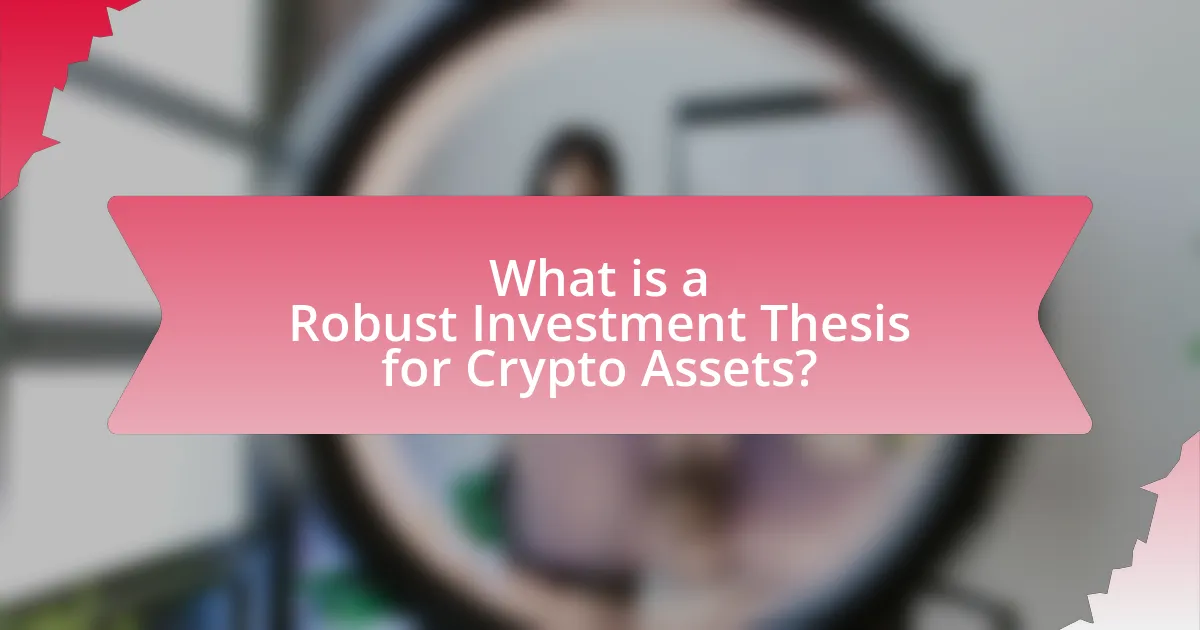A robust investment thesis for crypto assets is a structured framework that outlines the rationale for investing in cryptocurrencies, focusing on their potential for high returns, diversification, and technological innovation. The article details the key components of an effective investment thesis, including market analysis, technology assessment, regulatory considerations, and risk management. It emphasizes the importance of thorough research and continuous monitoring to adapt the thesis to evolving market conditions. Additionally, the article discusses methods for evaluating the effectiveness of the thesis and highlights common pitfalls to avoid in its development, ensuring that investors can make informed decisions in the dynamic cryptocurrency landscape.

What is a Robust Investment Thesis for Crypto Assets?
A robust investment thesis for crypto assets is a well-researched framework that outlines the rationale for investing in cryptocurrencies, emphasizing their potential for high returns, diversification benefits, and technological innovation. This thesis should be grounded in an analysis of market trends, regulatory developments, and the underlying technology of specific cryptocurrencies, such as blockchain. For instance, the rapid adoption of decentralized finance (DeFi) and non-fungible tokens (NFTs) illustrates the growing utility and demand for crypto assets, supporting the argument for their long-term value. Additionally, historical data shows that Bitcoin, as the leading cryptocurrency, has outperformed traditional assets like gold and stocks over the past decade, reinforcing the thesis that crypto assets can serve as a viable investment option.
How does an investment thesis apply to crypto assets?
An investment thesis applies to crypto assets by providing a structured framework for evaluating their potential value and risks. This framework helps investors articulate their rationale for investing in specific cryptocurrencies or blockchain projects, considering factors such as technology, market demand, regulatory environment, and competitive landscape. For instance, an investment thesis might assert that Bitcoin’s scarcity and decentralized nature position it as a hedge against inflation, supported by historical data showing its price increase during economic downturns. This structured approach enables investors to make informed decisions and adjust their strategies based on evolving market conditions and new information.
What are the key components of a crypto investment thesis?
The key components of a crypto investment thesis include market analysis, technology assessment, regulatory environment, and risk management. Market analysis involves evaluating the demand and supply dynamics of specific cryptocurrencies, including their market capitalization and trading volume. Technology assessment focuses on the underlying blockchain technology, its scalability, security features, and potential use cases. The regulatory environment examines existing and potential regulations that could impact the cryptocurrency market, influencing its adoption and legality. Lastly, risk management identifies potential risks such as market volatility, security breaches, and regulatory changes, allowing investors to make informed decisions. Each component is essential for constructing a comprehensive and effective investment thesis in the cryptocurrency space.
How does market analysis influence a crypto investment thesis?
Market analysis significantly influences a crypto investment thesis by providing data-driven insights into market trends, investor sentiment, and competitive dynamics. This analysis helps investors identify potential opportunities and risks associated with specific cryptocurrencies. For instance, historical price movements and trading volumes can reveal patterns that inform future price predictions, while sentiment analysis can gauge public perception and potential market reactions. Additionally, understanding regulatory developments and technological advancements within the crypto space can shape an investment thesis by highlighting factors that may impact asset valuation. Thus, a thorough market analysis equips investors with the necessary context to make informed decisions, ultimately enhancing the robustness of their investment thesis.
Why is a robust investment thesis important for crypto investors?
A robust investment thesis is crucial for crypto investors because it provides a structured framework for decision-making and risk assessment. This framework helps investors evaluate the potential of various cryptocurrencies based on market trends, technology, and regulatory factors. For instance, a well-defined thesis can guide investors in identifying undervalued assets or emerging technologies, thereby enhancing their chances of achieving significant returns. Additionally, a strong investment thesis allows investors to remain disciplined during market volatility, as it serves as a reference point for their investment strategy.
What risks does a well-defined thesis mitigate?
A well-defined thesis mitigates risks such as ambiguity, misalignment of investment goals, and poor decision-making. By clearly articulating the investment rationale, a well-defined thesis reduces the likelihood of misunderstandings regarding the objectives and strategies involved in crypto asset investments. This clarity helps investors stay focused on their goals and avoid emotional or impulsive decisions that can arise from market volatility. Furthermore, a well-structured thesis provides a framework for evaluating potential investments, thereby minimizing the risk of investing in assets that do not align with the investor’s overall strategy.
How can a strong thesis enhance investment decision-making?
A strong thesis enhances investment decision-making by providing a clear framework for evaluating potential investments. This framework allows investors to systematically assess the viability and risks associated with crypto assets, leading to more informed choices. For instance, a well-defined thesis can incorporate market trends, technological advancements, and regulatory considerations, which are critical in the volatile crypto landscape. Research indicates that investors with a structured thesis are more likely to achieve better returns, as they can avoid impulsive decisions driven by market fluctuations.

What steps are involved in creating a robust investment thesis for crypto assets?
Creating a robust investment thesis for crypto assets involves several key steps. First, conduct thorough market research to understand the current landscape, including trends, key players, and regulatory environments. This research should include analyzing historical price movements and market cycles, which can provide insights into potential future performance.
Next, define the specific crypto assets of interest by evaluating their use cases, technology, and underlying fundamentals. Assess the project’s whitepaper, team credentials, and community support to gauge its viability and potential for growth.
Following this, establish clear investment criteria, including risk tolerance, investment horizon, and expected returns. This framework will guide decision-making and help in evaluating whether a particular asset aligns with your investment goals.
Additionally, develop a risk management strategy that includes diversification across different assets and sectors within the crypto space. This approach mitigates potential losses and balances the overall portfolio.
Finally, continuously monitor and reassess the investment thesis based on market developments, technological advancements, and changes in regulatory frameworks. This iterative process ensures that the thesis remains relevant and aligned with evolving market conditions.
How do you conduct thorough research for your thesis?
To conduct thorough research for a thesis on creating a robust investment thesis for crypto assets, one must systematically gather and analyze relevant data from credible sources. This involves identifying key areas such as market trends, regulatory developments, and technological advancements in the crypto space. Utilizing academic journals, industry reports, and reputable financial news outlets provides a solid foundation for understanding the landscape. For instance, a report by Chainalysis highlights the growth of cryptocurrency adoption, indicating a significant increase in user engagement and market capitalization, which can inform investment strategies. Additionally, engaging with expert opinions through interviews or podcasts can offer unique insights that enhance the research quality.
What sources of information are most reliable for crypto research?
The most reliable sources of information for crypto research include established financial news outlets, academic journals, and blockchain analytics platforms. Financial news outlets like CoinDesk and Bloomberg provide timely updates and expert analysis on market trends. Academic journals, such as the Journal of Cryptology, offer peer-reviewed research that contributes to a deeper understanding of blockchain technology and its implications. Blockchain analytics platforms, like Glassnode and Chainalysis, provide data-driven insights into market behavior and network activity, enhancing the research quality. These sources are recognized for their credibility and accuracy in the rapidly evolving cryptocurrency landscape.
How do you evaluate the credibility of crypto projects?
To evaluate the credibility of crypto projects, analyze their whitepapers, team backgrounds, and community engagement. A well-structured whitepaper outlines the project’s goals, technology, and use cases, providing transparency. The team’s experience and track record in the blockchain space indicate their capability to execute the project. Additionally, active community engagement on platforms like GitHub and social media reflects the project’s transparency and responsiveness to user feedback. For instance, projects like Ethereum and Cardano have established credibility through comprehensive whitepapers, experienced teams, and vibrant communities, which have contributed to their long-term success and adoption.
What factors should be considered when formulating your thesis?
When formulating a thesis for crypto assets, key factors to consider include market trends, regulatory environment, technological advancements, and risk assessment. Market trends provide insights into price movements and investor sentiment, which are crucial for predicting future performance. The regulatory environment affects the legality and operational framework of crypto assets, influencing their adoption and stability. Technological advancements, such as blockchain innovations, can enhance the utility and security of crypto assets, impacting their long-term viability. Lastly, a thorough risk assessment identifies potential vulnerabilities, including market volatility and security threats, ensuring a comprehensive understanding of the investment landscape.
How do market trends impact your investment thesis?
Market trends significantly influence an investment thesis by providing insights into the potential future performance of assets. For instance, a bullish trend in cryptocurrency markets often indicates increased investor confidence, leading to higher asset valuations and potential returns. Conversely, a bearish trend may suggest declining interest and lower prices, prompting a reevaluation of investment strategies. Historical data shows that during the 2017 cryptocurrency boom, market trends led to a surge in investments, with Bitcoin reaching nearly $20,000, while the subsequent downturn in 2018 resulted in a significant loss of value, highlighting the importance of aligning investment theses with prevailing market conditions.
What role does technology play in shaping your thesis?
Technology is fundamental in shaping the thesis on creating a robust investment thesis for crypto assets by providing the necessary tools for data analysis, market research, and transaction security. Advanced technologies such as blockchain enhance transparency and trust in crypto transactions, while data analytics platforms enable investors to assess market trends and asset performance effectively. For instance, the use of machine learning algorithms can analyze vast datasets to predict market movements, thereby informing investment decisions. Additionally, technological advancements in cybersecurity protect investors from fraud and hacking, which is crucial in the volatile crypto market. These elements collectively reinforce the thesis by ensuring that investment strategies are data-driven, secure, and adaptable to market changes.

How can you refine and test your investment thesis over time?
To refine and test your investment thesis over time, regularly review and analyze market data, performance metrics, and emerging trends in the crypto space. This process involves adjusting your thesis based on new information, such as changes in regulatory environments or technological advancements, which can significantly impact asset valuations. For instance, the introduction of Ethereum 2.0 in 2020 altered the investment landscape for Ethereum, prompting investors to reassess their positions. Additionally, conducting periodic backtesting against historical data can validate the effectiveness of your thesis, allowing you to identify strengths and weaknesses in your investment strategy. By maintaining a disciplined approach to monitoring and adapting your thesis, you can enhance its robustness and relevance in a rapidly evolving market.
What methods can be used to evaluate the effectiveness of your thesis?
To evaluate the effectiveness of your thesis on crypto assets, you can use methods such as backtesting, peer review, and performance metrics analysis. Backtesting involves applying your thesis to historical data to assess its predictive accuracy and profitability, which provides concrete evidence of its viability. Peer review allows experts in the field to critique your thesis, offering insights and validation based on their experience and knowledge. Performance metrics analysis includes measuring key indicators such as return on investment (ROI), volatility, and risk-adjusted returns, which quantitatively demonstrate the thesis’s effectiveness in real-world scenarios. These methods collectively ensure a comprehensive evaluation of your investment thesis.
How do you adjust your thesis based on market changes?
To adjust a thesis based on market changes, one must continuously analyze market trends, data, and sentiment to identify shifts that impact asset valuations. For instance, if a significant regulatory change occurs, such as the introduction of stricter cryptocurrency regulations, it may necessitate a reevaluation of the investment thesis to account for potential impacts on market liquidity and investor confidence. Historical data shows that regulatory announcements can lead to immediate price volatility, as seen in the aftermath of China’s cryptocurrency ban in 2017, which caused a sharp decline in market prices. Therefore, staying informed and responsive to such developments is crucial for maintaining a relevant and effective investment thesis in the dynamic crypto market.
What indicators signal the need for a thesis revision?
Indicators that signal the need for a thesis revision include significant market changes, new regulatory developments, and shifts in investor sentiment. For instance, if a major cryptocurrency experiences a drastic price fluctuation, it may necessitate a reevaluation of the investment thesis to ensure it aligns with current market conditions. Additionally, the introduction of new regulations affecting the crypto market can impact the viability of the thesis, requiring updates to reflect compliance and strategic adjustments. Lastly, if surveys or sentiment analysis reveal a notable change in investor confidence or interest in specific crypto assets, this could indicate that the original thesis may no longer be valid, prompting a revision to incorporate these insights.
What best practices should you follow when creating an investment thesis for crypto assets?
When creating an investment thesis for crypto assets, it is essential to conduct thorough research and analysis of the underlying technology, market trends, and regulatory environment. This involves evaluating the project’s whitepaper, understanding its use case, and assessing the team behind it. For instance, a study by CoinDesk in 2021 highlighted that projects with transparent roadmaps and experienced teams tend to perform better in the long run. Additionally, diversifying investments across different crypto assets can mitigate risks, as evidenced by the volatility patterns observed in the cryptocurrency market. Finally, continuously monitoring market developments and adjusting the thesis accordingly is crucial, as the crypto landscape evolves rapidly.
How can you ensure your thesis remains relevant and actionable?
To ensure your thesis remains relevant and actionable, continuously update it based on market trends and emerging technologies in the crypto space. Regularly reviewing and integrating new data, such as regulatory changes or technological advancements, allows the thesis to adapt to the evolving landscape. For instance, the rapid development of decentralized finance (DeFi) and non-fungible tokens (NFTs) has significantly influenced investment strategies, demonstrating the need for ongoing adjustments to maintain relevance.
What common pitfalls should be avoided in thesis development?
Common pitfalls to avoid in thesis development include lack of clarity, insufficient research, and failure to define a specific scope. Lack of clarity can lead to a vague thesis statement, making it difficult for readers to understand the main argument. Insufficient research results in weak support for claims, undermining the thesis’s credibility. Failure to define a specific scope can lead to an overly broad thesis that lacks focus, making it challenging to develop coherent arguments. These pitfalls can significantly weaken the overall quality of the thesis and hinder effective communication of ideas.















